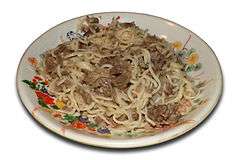Beshbarmak



Beshbarmak (Kyrgyz: бешбармак, Russian: бешбармак, Bashkir: бишбармаҡ, Tatar: бишбармак — "five finger") is the national dish among nomadic Turkic peoples in Central Asia and Russia. It is also known as Naryn (in Xinjiang, Uzbekistan, Kyrgyzstan and Kazakhstan), as Turama/Dograma (in Karakalpakstan, North Caucasus and Turkmenistan) and as Kullama (in Bashkortostan and Tatarstan).
The term Beshbarmak means "five fingers", because nomads used to eat this dish with their hands. The boiled meat is finely chopped with knives, mixed with boiled noodles, and spiced with onion sauce. It is usually served in a big round dish. Beshbarmak is usually served with shorpo – mutton broth in bowls called kese. Typically, shorpo is served as a first course that is followed by courses of beshbarmak and a drink called ak-serke (shorpo spiced with kymyz or ayran).
Historical background
The cuisine of Central Asia developed within the constraints of a nomadic life, when people were completely reliant on their animals which is reflected in their food, which is rich in meat and dairy products.
The serving ritual
The serving of beshbarmak is steeped in ritual with different sections of the meat proportioned to people depending on their gender, age and rank in the social structure. On special occasions, a lamb's head may be served on the table. It is served to the most respected person, and he cuts off pieces from her and treats others with various desires. Festive beshbarmak could be cooked with Kazy together.
Making Beshbarmak
No special equipment is needed to make Beshbarmak. A pot to boil the meat and noodles in is required, as well as a rolling pin and knife to prepare the pasta. Beshbarmak is an easy dish to prepare. Initially meat is boiled. In the original version of Beshbarmak you should ideally use a piece of hind quarters (rump) of a horse, kazy and sujuk (horse meat products), rack of lamb . It may change with the seasons. In warm seasons, beshbarmak is usually cooked using meat lamb. At the same time we make dough using flour, water and eggs, add salt and let it sit for 40 minutes. After that we roll out the pastry, making it very thin, and cut it into noodles. The noodles are boiled in meat-broth for 5–10 minutes. The boiled noodles and finely chopped meat is placed on a tray ("tabak") and sauce (called "chyk" or "tuzdyk", made of onion, ground black pepper and hot meat-broth) is poured. Then everything is thoroughly mixed. Finely chopped meat in beshbarmak is a sign of respect for elders and guests. Presentation is also important. The dish is layered on big tray. Hospitality is serious business in Central Asia. Ordinarily, being invited for beshbarmak is an honor. Guests are never invited to sit at an empty table, but beshbarmak is always presented after all the guests have been assembled. It is still a dish that carries with it nomadic identity, and not one to be taken lightly.